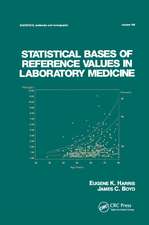Healthcare Analytics: Emergency Preparedness for COVID-19
Editat de Edward M. Rafalski, Ross M. Mullneren Limba Engleză Paperback – 7 oct 2024
This book therefore addresses a compelling need for documenting what has been learned by the academic and professional healthcare communities in healthcare analytics and disaster preparedness to this point in the pandemic. What is clear, at least from the US perspective, is that the healthcare system was unprepared and uncoordinated from an analytics perspective. Learning from this experience will only better prepare all healthcare systems and leaders for future crisis.
Both prospectively, from a modeling perspective and retrospectively from a root cause analysis perspective, analytics provide clarity and help explain causation and data relationships. A more structured approach to teaching healthcare analytics to students, using the pandemic and the rich dataset that has been developed, provides a ready-made case study from which to learn and inform disaster planning and preparedness. The pandemic has strained the healthcare and public health systems. Researchers and practitioners must learn from this crisis to better prepare our processes for future pandemics, at minimum. Finally, government officials and policy makers can use this data to decide how best to assist the healthcare and public health systems in crisis.
| Toate formatele și edițiile | Preț | Express |
|---|---|---|
| Paperback (2) | 306.64 lei 6-8 săpt. | |
| CRC Press – 7 oct 2024 | 306.64 lei 6-8 săpt. | |
| Taylor & Francis – 10 sep 2019 | 324.50 lei 6-8 săpt. | |
| Hardback (2) | 773.29 lei 6-8 săpt. | |
| CRC Press – 9 aug 2022 | 773.29 lei 6-8 săpt. | |
| Taylor & Francis – 12 sep 2019 | 842.73 lei 6-8 săpt. |
Preț: 306.64 lei
Preț vechi: 349.43 lei
-12% Nou
Puncte Express: 460
Preț estimativ în valută:
58.70€ • 60.37$ • 48.70£
58.70€ • 60.37$ • 48.70£
Carte tipărită la comandă
Livrare economică 17 februarie-03 martie
Preluare comenzi: 021 569.72.76
Specificații
ISBN-13: 9781032068466
ISBN-10: 1032068469
Pagini: 264
Ilustrații: 118
Dimensiuni: 156 x 234 mm
Greutate: 0.49 kg
Ediția:1
Editura: CRC Press
Colecția CRC Press
Locul publicării:Boca Raton, United States
ISBN-10: 1032068469
Pagini: 264
Ilustrații: 118
Dimensiuni: 156 x 234 mm
Greutate: 0.49 kg
Ediția:1
Editura: CRC Press
Colecția CRC Press
Locul publicării:Boca Raton, United States
Public țintă
Academic, Postgraduate, and ProfessionalCuprins
Introduction – Edward M. Rafalski
I. Section 1 – Epidemiology and analytics
1. What is a pandemic, an epidemic? – Jonathan A. McCullers
2. A brief history of pandemics – Jonathan A. McCullers
3. Health care continuum – Edward M. Rafalski
4. The fog of war and data – Edward M. Rafalski
5. Sources of data/modeling – Edward M. Rafalski and Robert Marksthaler
6. Quantifying and responding to COVID's financial and operational impact – Mark Grube and Rob Fromberg
II. Section 2 - State case studies
7. Measuring and addressing healthcare employee well-being in an Alabama health system during COVID-19 – Katherine A. Meese et al.
8. Colorado state case study - Adom Netsanet et al.
9. Case study: A Florida COVID-19 dashboard – Zachary Pruitt et al.
10. State case study: Illinois – Helen Margellos-Anast et al.
11. Tennessee case study – Cori Cohen Grant et al.
12. Regional modeling – Madeleine McDowell et al.
III. Section 3 - Topics
13. Healthcare analytics: The effects of the pandemic on behavioral health – Kasey Knopp and Naakesh (Nick) Dewan
14. Digital transformation in healthcare: How COVID-19 was an agent for rapid change – Bala Hota and Omar Lateef
15. Telehealth – Richard Fine
16. The COVID-19 pandemic and development of drugs and vaccinations – Pradeep S. B. Podila
16. Value of health information exchanges to support public health reporting – Pradeep S. B. Podila
Conclusion – Edward M. Rafalski and Ross M. Mullner
Epilogue – Edward M. Rafalski
I. Section 1 – Epidemiology and analytics
1. What is a pandemic, an epidemic? – Jonathan A. McCullers
2. A brief history of pandemics – Jonathan A. McCullers
3. Health care continuum – Edward M. Rafalski
4. The fog of war and data – Edward M. Rafalski
5. Sources of data/modeling – Edward M. Rafalski and Robert Marksthaler
6. Quantifying and responding to COVID's financial and operational impact – Mark Grube and Rob Fromberg
II. Section 2 - State case studies
7. Measuring and addressing healthcare employee well-being in an Alabama health system during COVID-19 – Katherine A. Meese et al.
8. Colorado state case study - Adom Netsanet et al.
9. Case study: A Florida COVID-19 dashboard – Zachary Pruitt et al.
10. State case study: Illinois – Helen Margellos-Anast et al.
11. Tennessee case study – Cori Cohen Grant et al.
12. Regional modeling – Madeleine McDowell et al.
III. Section 3 - Topics
13. Healthcare analytics: The effects of the pandemic on behavioral health – Kasey Knopp and Naakesh (Nick) Dewan
14. Digital transformation in healthcare: How COVID-19 was an agent for rapid change – Bala Hota and Omar Lateef
15. Telehealth – Richard Fine
16. The COVID-19 pandemic and development of drugs and vaccinations – Pradeep S. B. Podila
16. Value of health information exchanges to support public health reporting – Pradeep S. B. Podila
Conclusion – Edward M. Rafalski and Ross M. Mullner
Epilogue – Edward M. Rafalski
Notă biografică
Edward M. Rafalski is Adjunct Assistant Professor at University of Illinois School of Public Health, and an Affiliate Associate Professor at the University of South Florida, College of Public Health. He holds qualifications from the University of Chicago and Yale University School of Public Health.
Recenzii
The epilogue was written just as the Pfizer and Moderna Covid-19 vaccines received approval—a remarkable moment in US health care history. Interactions among local, state, and federal governments and information sharing within the health care industrial complex are the overall focus of analysis. From case studies of wellness among Alabama health care workers to analysis of Colorado hospitals' financial decisions and race-based health inequities in Chicago, this is an ideal textbook for courses on government impacts on health care, health care policy, and/or the COVID-19 response. Part lessons learned, part social commentary, part technological interoperability analysis, this is a well-referenced gem cast in straightforward language.
- K. O'Grady, University of San Diego
- K. O'Grady, University of San Diego
Descriere
This book addresses a compelling need for documenting what has been learned by the academic and professional healthcare communities in healthcare analytics and disaster preparedness to this point in the COVID-19 pandemic.

























